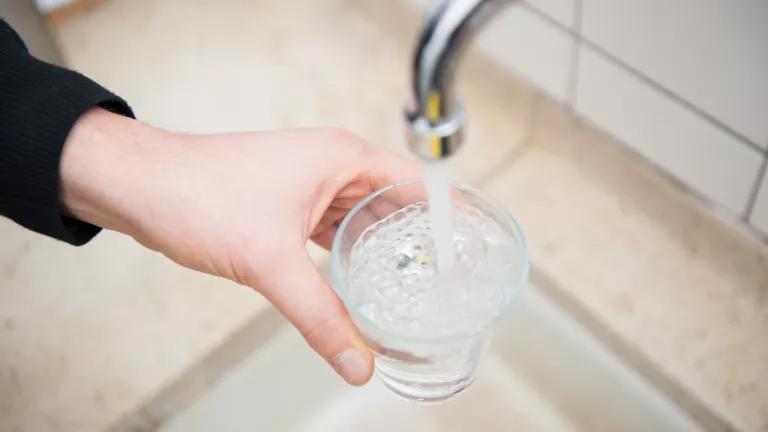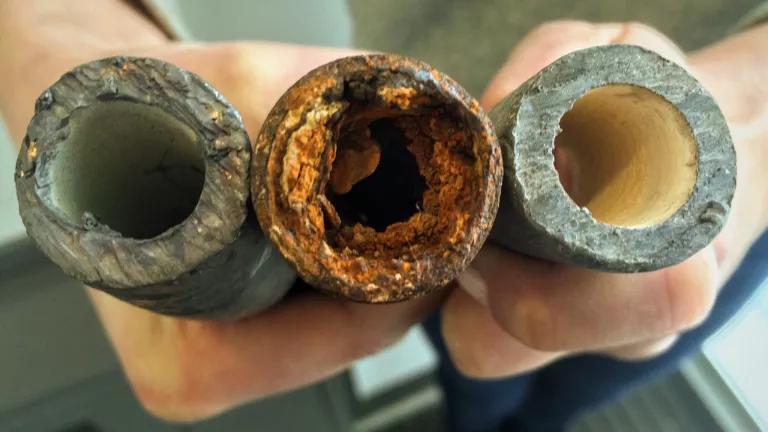Federal COVID-19 Relief for Water & Sewer Bills
Maintaining access to water and other essential utility services remains as vital as ever to safeguard public health, as the pandemic continues.
This blog is co-authored by Larry Levine (NRDC) and Olivia Wein (National Consumer Law Center).
For many of us, the accelerating rollout of COVID-19 vaccines provides hope for a light at the end of the tunnel. But the vaccines are still in a race against time, with COVID-19 again resurging in many states.
Maintaining access to water and other essential utility services remains as vital as ever to safeguard public health, as the pandemic continues. A recent report by Duke University researchers found that, if utility disconnections had been barred nationwide from March through November 2020, COVID-19 infections rates could have been reduced by 8.7% and deaths by 14.8%.
But tens of millions of people are continuing to accumulate tens of billions of dollars of overdue utility bills. Water and other utility services already have been disconnected for at least hundreds of thousands families unable to pay these bills, with more at risk every day. The risk of disconnection disproportionately harms communities of color. According to research at Indiana University that looked at a nationally representative sample of households below 200% of the Federal Poverty Level, 20% of Black households and 28% of Hispanic households reported being unable to pay an energy bill between June and August 2020, compared to just 12% of white households.
The Biden Administration and Congress have not acted on urgent calls to ban water shutoffs during the COVID-19 pandemic. Only eight states have statewide water shutoff moratoria in place today. At least one of those states (Wisconsin) is set to end its moratorium on April 15, placing over 20,000 households at risk of shutoff. Some individual water utilities are continuing to suspend shutoffs, even after state bans expire, while some others never do shutoffs at all for non-payment. But in cities and towns all around the country – in Texas, Ohio, Indiana, South Carolina, Florida, Tennessee, Pennsylvania, North Carolina, Illinois, and more – utilities have resumed cutting off water when people can’t afford to pay.
When the remaining state or local moratoria are lifted, residential water customers who lose shutoff protections will face billions of dollars in arrears. In California and New York City alone, for example, residential water arrears total over $1.6 billion, with over 1.7 million households affected.* Unsurprisingly, when California examined its statewide data, low-income communities of color had disproportionately high levels of household water debt.
The good news is that the recent federal COVID-19 relief packages – including President Biden’s American Rescue Plan enacted in March 2021 – provide billions of dollars that can help low-income families struggling to pay their water and sewer bills.
These funds can help millions keep their water running and dig out from a mountain of utility debt, while helping utilities offset decreased revenue without raising rates. Most of the assistance is provided through new, emergency programs, although some is provided through pre-existing programs.
NRDC and the National Consumer Law Center (NCLC) have just published a new fact sheet summarizing six federal COVID-19 relief programs that are either dedicated to, or can be used for, low income water and wastewater assistance. The fact sheet provides a guide for advocates, utilities, and state and local officials who are seeking to help customers with past due and unaffordable water and sewer bills.
Where available, the fact sheet provides links to federal program webpages and funding allocations to state, territorial, Tribal, and local grantees. It also notes where federal agencies have not yet provided critical details, such as how the program funds will be allocated and how programs will be structured.
Most significantly, for the first time ever, Congress in December 2020 and March 2021 appropriated funds specifically for low-income water and wastewater assistance – a total of $1.138 billion for an emergency Low Income Household Water Assistance Program (LIHWAP). The U.S. Department of Health and Human Services (HHS) has not announced program rules or released funds to the states. The fact sheet describes what is currently known of the program and will be updated as HHS releases more information.
NRDC and NCLC have submitted recommendations to HHS on how to implement LIHWAP equitably and efficiently. We offered specific program design recommendations to deliver assistance to those with the greatest need; maximize public health benefits by using program funds to protect access to essential water service; ensure accountability for program spending by states and utilities; and generate data to evaluate the effectiveness of the program and determine how to improve upon it. States should heed the same recommendations as they set up their own programs to administer LIHWAP funds. (Allied organizations have also submitted similar recommendations to HHS, including a letter organized by frontline advocates that NRDC also joined.)
The fact sheet also describes five other relevant programs:
- Emergency Rental Assistance ($46.6 billion) – In addition to helping pay rent, state and local governments may elect to use these funds to help low income tenants pay past due utility bills (up to 12 months of arrears) and current bills, including water and wastewater bills. [UPDATE: As one example, Philadelphia is offering eligible renters (or landlords on their behalf) up to $2,000 for past due or current month water bills, drawing on the city’s $97m share of these funds.]
- FEMA Emergency Food and Shelter Program ($400 million) – This pre-existing program funds local agencies to provide an array of emergency assistance, including a month of utility assistance to tenants at risk of eviction or homeowners at risk of foreclosure.
- Homeowners Assistance Fund ($10 billion) – This foreclosure prevention programs includes assistance with utility bills (including water) as an eligible use of funds.
- Coronavirus State and Local Fiscal Recovery Funds ($350 billion) – Each state and local government may use its share of these funds for a wide range of purposes, including backfilling lost government revenue (such as decreased collections from customers of municipal utilities), providing assistance to households experiencing adverse economic impacts of the COVID-19 emergency, and even “necessary investments in water [or] sewer…infrastructure.”
- CARES Act – Some state and local governments still have funds remaining from the March 2020 CARES Act. Congress extended the deadline to spend these funds until the end of 2021. Various categories of CARES Act money can be used for low income water and wastewater assistance. Some state and local governments have already chosen to do so.
You can download the fact sheet here or view it below. Check back for updates as more information becomes available.
*Note: This combined total for New York City and California is likely a conservative estimate. In New York City, the numbers reported include only water and sewer accounts that are at least 180 days overdue; the total of all overdue water and sewer bills in New York City is certainly much higher. In California, the reported $1 billion in overdue residential bills includes about $600 million for customers of water utilities or combined water/sewer utilities, and about $400 million for customers who receive a combined bill for water and power from the same utility. However, the California data do not include arrears for customers of wastewater-only utilities.



